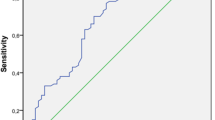Abstract
It has been hypothesized that chronic inflammation may play an important role in the development and progression of the neurodegeneration of Idiopathic Parkinson’s disease (IPD). Neutrophil–lymphocyte ratio (NLR) is a marker that indicates the peripheral inflammation. There is only one study regarding NLR and IPD. In this study, we assessed to investigate NLR in patients with IPD, comparing the results with controls and to determine whether there is a difference in NLR levels in subgroups of IPD (akinetic-rigid and tremor-dominant) differ in their levels of NLR. Medical records of 200 IPD patients and 60 controls reviewed retrospectively. Forty-six IPD patients met the inclusion criteria. NLR was calculated by dividing neutrophil count to lymphocyte count. Thirteen akinetic-rigid (AR-IPD) and thirty-three tremor-dominant (TD-IPD) patients’ and controls results were compared. There was not a statistically difference between the NLR levels of IPD patients, controls, and AR-IPD and TD-IPD patients. This result suggests that cerebral inflammation is in the forefront in the development of neurodegeneration in IPD, and that more evidence is needed for the role of peripheral inflammation in the development progression of disease.
Similar content being viewed by others
References
Akıl E, Bulut A, Kaplan İ, Özdemir HH, Arslan D, Aluçlu MU (2015) The increase of carcinoembryonic antigen (CEA), high-sensitivity C-reactive protein, and neutrophil/lymphocyte ratio in Parkinson’s disease. Neurol Sci 36:423–428
Alberio T, Pippione AC, Comi C, Olgiati S, Cecconi D, Zibetti M, Lopiano L, Fasano M (2012) Dopaminergic therapies modulate the T-cell proteome of patients with Parkinson’s disease. IUBMB Life 64:846–852
Alkhouri N, Morris-Stiff G, Campbell C, Lopez R, Tamimi TA, Yerian L, Zein NN, Feldstein AE (2012) Neutrophil to lymphotocyte ratio: a new marker for predicting steatohepatitis and fibrosis in patients with nonalcoholic fatty liver disease. Liver Int 2:297–302
Baba Y, Kuroiwa A, Uitti RJ, Wszolek KZ (2005) Yamada T. Alterations of T-lymphocyte populations in Parkinson disease. Parkinsonism Relat Disord 11:493–498
Dobbs RJ, Charlet A, Purkiss AG, Dobbs SM, Weller C, Peterson DW (1999) Association of circulating TNF-α and IL-6 with ageing and parkinsonism. Acta Neurol Scad. 100:4–31
Dufek M, Hamanova M, Lokaj J, Goldemund D, Rektorava I, Michalklova Z, Sheardova K, Rektor IM (2009) Serum inflamatory biomarkers in Parkinson’s disease. Parkinsonism Relat Disord 5:318–320
Ferrari CC, Tarelli R (2011) Parkinson’s disease and systemic inflamation. Parkinson’s Dis. doi:10.4061/2011/436813
Hisanaga K, Asagi M, Itoyama Y, Iwasaki Y (2001) Increase in peripheral CD bright +CD8 dull T cells in Parkinson disease. Arc Neurol. 58:1580–1583
Hughes AJ, Daniel SE, Kilford L, Lees AJ (1992) The accuracy of clinical diagnosis of idiopathic Parkinson’s disease: a clinicopathological study. J Neurol Neurosurg Psychiatry 55:181–184
Jung MR, Park YK, Jeong O, Sean JW et al (2012) Elevated preoperative neutrophil to lymphocyte ratio predicts poor survival following resection in late stage gastric cancer. J Surg Oncol 104:504–510
Kustrimovic N, Rasini E, Legnaro M, Bombelli R, Aleksic I, Blandini F, Comi C, Mauri M, Minafra B, Riboldazzi G, Sanchez-Guajardo V, Marino F, Cosentino M (2016) Dopaminergic receptors on CD4+ T naive and memory lymphocytes correlate with motor impairment in patients with Parkinson’s disease. Sci Rep 6:33738
Long-Smith CM, Sullivan AM, Nolan YM (2009) The influence of microglia on the pathogenesis of Parkinson’s disease. Prog Neurobiol 89:277–287
McGeer PL, McGeer EG (2004) İnflammation and neurodegeneration in Parkinson’s disease. Parkinsonism Relat Disord 10:3–7
McGeer PL, Itagaki S, Akiyama H, McGeer EG (1988) Rate of cell death in parkinsonism indicates active neuropathological process. Ann Neurol 24:574–576
McGeer PL, Itagaki S, Boyes BE, McGeer EG (1988) Reactive microglia are positive for HLA-DR in the substantia nigra of Parkinson’s and Alzheimer’s Disease brains. Neurology 38:1285–1291
Movement Disorder Society Task Force on Rating Scales for Parkinson’s Disease (2003) The unified Parkinson’s disease rating scale (UPDRS): status and recommendations. Mov Disord 18:738–750
Pacheco R, Prado CE, Barrientos MJ, Bernales S (2009) Role of dopamin in the physiology of T-cells and dendritic cells. J Neuroimmunol 216:8–19
Phani S, Loike JD, Przedborski S (2012) Neurodegeneration and Inflammation in Parkinson’s disease. Parkinsonism Relat Disord 1851:207–209
Przedborski S (2007) Neuroinflamation and Parkinson’s disease. In: Vinken PJ, Bruyn GW (eds) Handbook of clinical neurology. Elsevier, Amsterdam, pp 535–551
Rembach A, Wilson B, Ellis K, Amos D, Rowe C et al (2013) Neutrophil-lymphocyte ratio in Alzheimer’s disease: data from Australian Imaging Biomarker and Lifestyle study of ageing. Alzheimers & Dementia 9:203
Sarkar C, Basu B, Chakroborty D, Dasgupta PS, Basu S (2010) The immunoregulatory role of dopamine: an update. Brain Behav Immun 24:525–528
Scalzo P, Kummer A, Cardoso F, Teixeira AL (2009) Increased serum levels of soluble tumor necrosis factor-α receptor-1 in patients with Parkinson’s disease. Journal Neuroimmunol. 216:122–125
Yamada T, McGeer PL, McGeer EG (1991) Relationship of complement-activated oligodendrocytes to reactive microglia and neuronal pathology in neurodegenerative disease. Dementia 2:71–77
Author information
Authors and Affiliations
Corresponding author
Ethics declarations
Conflict of interest
The authors have no conflict of interest to report.
Rights and permissions
About this article
Cite this article
Ataç Uçar, C., Gökçe Çokal, B., Ünal Artık, H.A. et al. Comparison of neutrophil–lymphocyte ratio (NLR) in Parkinson’s disease subtypes. Neurol Sci 38, 287–293 (2017). https://doi.org/10.1007/s10072-016-2758-8
Received:
Accepted:
Published:
Issue Date:
DOI: https://doi.org/10.1007/s10072-016-2758-8




